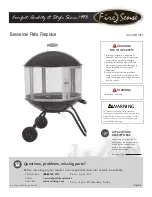
OPERATION & SERVICE
Servicing should only be performed by a Qualified Service Agent
10
OPERATION & SERVICE
This section of the manual will cover the principles of electricity, single and three phase
power, fuses, surface mount thermostat/ECO combination controls, heating element
construction & operation, heating element sensors, contactors, common service procedures
and more. Information and service procedures presented in this section will be referenced in
the troubleshooting sections.
PRINCIPLES OF ELECTRICITY
Voltage
The unit of measurement used to quantify electrical pressure or the force that causes
electrical energy to flow is the volt or voltage. Volt meters are used to determine if there is an
adequate supply of electricity or voltage to a heating element.
Amperage
The unit of measurement used to quantify the rate at which electrical current is flowing is the
ampere or amp. Amp meters are used to determine if a heating element is working - if there
is adequate current flowing through the heating element.
Ohms
The unit of measurement used to quantify the opposition or “resistance” to the flow of
electricity is the ohm. As resistance (
ohms
) in an electrical circuit increases current
(
amperage
) will decrease and as resistance decreases current will increase. Ohm meters
are used for measuring the resistance of heating elements, for open circuit continuity tests
on heating elements and for shorted to ground continuity tests on heating elements.
Service Note:
Volt, ohm and amp meter test instruments are necessary to perform the
service and diagnostic procedures outlined in this manual - see Tools Required on page 3.
Wattage
The unit of measurement used to quantify the rate or amount of electrical energy being used
is the watt. One thousand watts is referred to as one kilowatt. Heating elements are rated in
kilowatts expressed as KW. The higher the kilowatt rating of a heating element the more
power it will use and the more heat it will generate. One kilowatt generates 3412 Btu of heat.













































